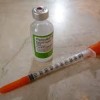Community-acquired, non-occupational needlestick injuries treated in US Emergency Departments
Abstract
BACKGROUND: The escalating number of persons self-injecting medications, predominantly insulin, has generated concerns that the public is at risk of acquiring blood-borne infections from discarded needles/syringes. Communities have developed disposal guidelines but a debate continues over the need for further legislation and/or at-home safety devices.… Read more
